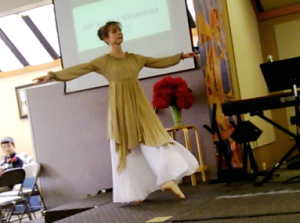 I’ve been studying choreography as part of the Dancing for Him course this past month and have compiled my ten favorite choreography tips and how I used them in the most recent dance I choreographed:
I’ve been studying choreography as part of the Dancing for Him course this past month and have compiled my ten favorite choreography tips and how I used them in the most recent dance I choreographed:
1. Begin with prayer. The Lord knows the moves that will minister to others. All creativity comes from Him. Pray about which song to use. Once you have chosen a song, spend time praying through the lyrics, asking the Lord to give you a picture of what He wants this dance to look like.
2. Keep your dance to 3 to 4 minutes, especially if it’s a solo. Unless you are very experienced and/or have a large group of dancers, it’s difficult to keep enough variety to hold the audiences interest longer than this. You want to hold the audience’s attention. You want to leave them wanting more, not ready for the ending. In the dance below, I had two songs on my heart to communicate the message for the congregation. So, I used Garage Band to clip the most appropriate and powerful sections of the song together and to make one song that is less than 4 minutes.
3. Use varying levels: You can do a similar movement or gesture at different levels to add interest to your dance. For example, you can stand on releve with your arm stretched to the Lord one time. Next, do the same gesture from a lunge. Finally, do the gesture while bowing. You can use this in a solo to add variety to the choruses. Or, if you are choreographing for a group, have different dancers do the same gesture at different levels.
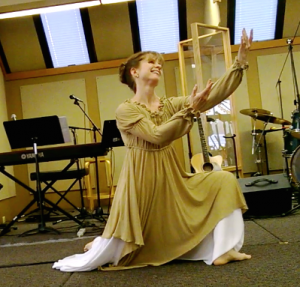
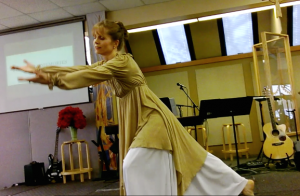
4. Choreograph for your skill level or even simpler. In the dance below, I wanted to do a tour jete to show joy in the chorus. But while I sometimes can do a beautiful tour jete in the studio, on the stage in church, I sometimes fall short. I didn’t want a mistake or weak moment to detract from the message of the dance, so I chose a simpler jump to illustrate the joy, one I knew I could reliably do with confidence. Other times, I have substituted a lunge with a reach for a develope with a ponche to avoid the risk of losing my balance. Know your ability and choreograph well within it.
5. Make use of motif. A motif is “a distinctive feature or dominant idea.” Pay attention to the theme of the song, most evident in the chorus. You may use similar movements or gestures to communicate the theme. You want to repeat the theme, but vary it. In the dance below, the theme was offering the time and place to the Lord. I used similar movements for “We give you this place” that gestured to the space, but varied them, varying my level and body alignment and slightly varying the gesture.
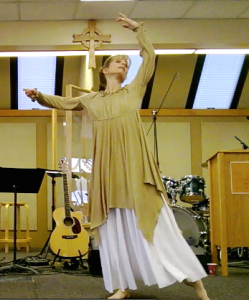
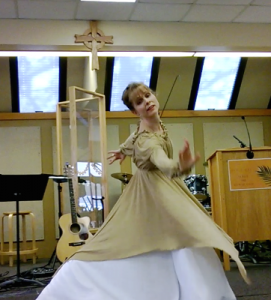
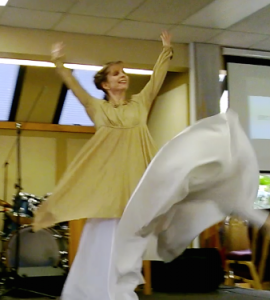
6. Travel from stage right to stage left for a greater impact in your entrance. This direction of movement has greater impact on the audience and is easiest to follow. From the audience’s perspective you are traveling from left to right, the same direction in which they read. There were two “entrances” in the dance below because I combined two songs. For both, I enter from stage right and travel to stage left.
7. Make the most of your body alignment. Different body alignments are more appropriate for different gestures/moves. If you are holding your body in the shape of the cross, it would be most effective to face directly forward (or backwards). The effect of this movement will be lost, if you are facing directly right or left. If, on the other hand. you are doing an arobesque, the beauty of this movement will be most evident from a side facing position, but would almost be lost if you are facing front. In the dance below, when I did a low bow, I wanted the audience to see the bow from the side to get the full impact, so I faced diagonally.
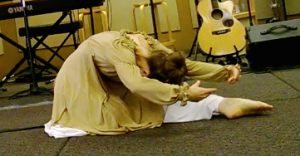
For more choreography tips, consider purchasing the Divine Choreography book or DVD.
Here’s a video in which I describe how I used a few of these tips:
And here is the full dance. The music was written by Douglas C. Eltzroth and comes from the “Refreshement of Praise” CD. It’s amazing music, but not easy to find in stores.
Do you have a favorite choreography tip? Please share it in the comments. We would love to hear from you.

love hearing and watching u at work. always lovely dear. I noticed the younger dancer on right of sanctuary. 🙂
Thanks, Diane. I love seeing that little one dancing in the background, such freedom and joy.
Hi Amy,
First let me say how beautiful your ministry in dance was! It brought such a peace.
A tip I can give is:
1. to start small when choreographing.
Like adding pieces of furniture, sometimes we don’t want to buy the whole ensemble or can’t for one reason or another, so it is in some of my choreography. I may include a turn a lunge and then a roll up. From there, i keep moving. Before I know it, I have movement phrases I like. I use discretion and prayer to change it in some places later, but that is one of my tips.
Blessings
Beverly
Thank you so much, Beverly, for your tip. I love the imagery of adding pieces of furniture and the wisdom of starting simply.